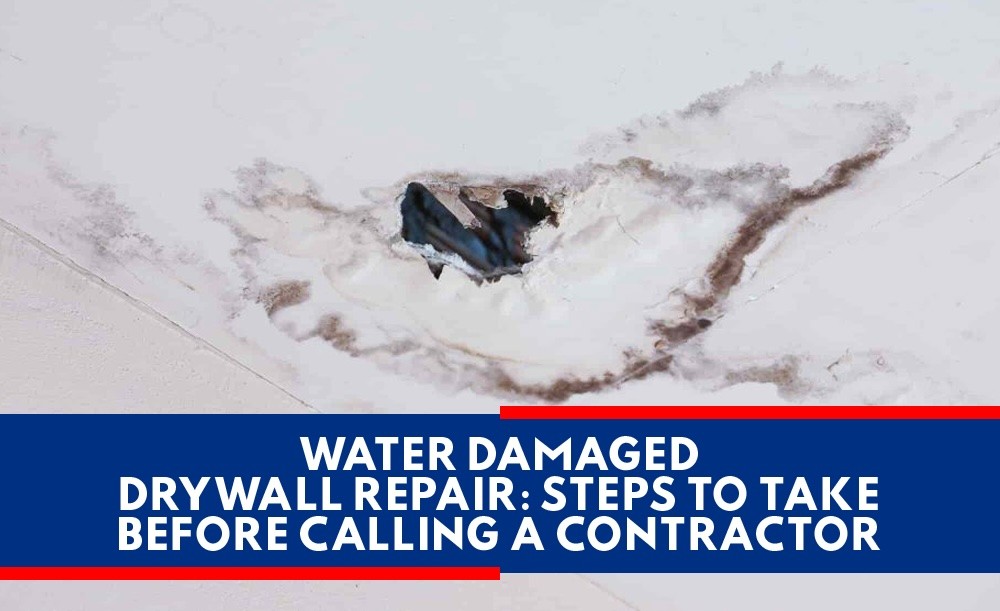DIY Drywall Repair: A Step-by-Step Guide to Fixing Common Issue
Water Damaged Drywall Repair: Steps to Take Before Calling a Contractor

Table of Contents
Water damage is a serious problem for homeowners, as it can cause extensive damage to both the interior and exterior of your home. One particularly common issue caused by water damage is damaged drywall – this can range from minor discoloration to large sections that need to be replaced entirely. If you have noticed any signs of water damage on your walls or ceilings, then several steps should be taken before calling in a drywall repair contractor for repairs.
In this article, we will discuss some of the key steps you should take if you’re dealing with water-damaged drywall in your home. From assessing the severity of the damage to identifying possible causes and preventing further issues, these tips will help ensure that your repair job goes smoothly and efficiently. With proper care and attention given to the process, repairing water-damaged drywall doesn't have to be an arduous task!
Don’t let yourself get overwhelmed when facing water-damaged drywall – by following our guide and taking proactive steps towards restoration, you can keep repair costs low while ensuring that the job is done correctly the first time around! Read on to learn more about what you should do if you find yourself in need of drywall repair due to water damage.
When water damage affects your drywall, it can seem almost impossible to repair. But with the right preparation and materials, you can get your walls back to their original state in no time. Start by determining how extensive the damage is - take photos and keep records of any losses for insurance purposes. Then look for hidden sources such as behind baseboards or walls, where mold may be growing. Once you have located all affected areas, it's time to start repairs with basic materials like drywall screws and other supplies needed to fix the issue. Finally, if necessary, call a professional for assistance to effectively repair water-damaged drywall.
Before beginning any water damage repair, it is important to first identify the source of the flooding and assess its severity. This will allow you to properly implement preventative measures so that similar issues don't happen in the future. Upon doing this, you can start gathering all the tools and supplies needed to carry out remediation procedures. In terms of materials, make sure to have wall material for drywall replacement if necessary as well as whatever is needed to address any peeling paint or wet drywall caused by moisture or dampness. With these precautions taken and the right tools at hand, your repairs can commence with confidence!
For proper repair work, the appropriate tools and supplies must be collected ahead of time. To begin, you will need a putty knife to scrape away any warped or softened drywall due to water damage. A utility knife can also come in handy for cutting out sections of damaged drywall that may not be salvageable. Additionally, if mold is present, then it's best to use gloves as well as face masks while handling materials.
After gathering up these items, it’s time to acquire replacement pieces such as fresh drywall sheets and joint compound needed for covering over patched holes and cracks. If applicable, insulation material should be purchased too depending on where water damage occurred to ensure an efficient repair job. Lastly, sandpaper would also prove useful for smoothing surfaces after repairs have been completed.
With the necessary tools and supplies now ready at your disposal, it’s time to take measurements and mark exactly where repairs are needed.
Before beginning any repairs, it's important to take precise measurements and make markings of where the water-damaged drywall should be replaced. First, inspect the area thoroughly to identify any signs of mold spores that may have occurred due to the water damage. If they are present, then extra caution must be taken while repairing this section as mold can spread quickly if not handled properly.
After inspecting for mold, begin measuring out the sizes needed for a replacement piece of drywall by using a ruler or tape measure. Mark down these dimensions with a pencil on both sides of the wall so exact cuts can be made later after removing old pieces. Don't forget to include length and width measurements when taking note of how much room is available for installation.
Finally, take one final look at all measurements and double-check them before proceeding to actual repair work. Once confidence has been established that everything lines up correctly, now is the time to move forward with replacing damaged areas of drywall to restore its original form once again.
When it comes to repairing drywall after water damage, the first step is assessing the severity of the damage and figuring out its source. If needed, bring in a mold remediation specialist to remove any present spores before beginning. Then mark off measurements before cutting out damaged areas with a saw or utility knife. Inspect for any further damages that may have previously gone unnoticed, like a burst pipe or water stains. Once this is done, attach new drywall pieces by securing them with screws - both tape and mud can be used depending on preference. Afterward, finish up by applying joint compound around all edges to make sure everything looks completely dry and fits together seamlessly.
For those looking for an even cleaner aesthetic result after repairs have been completed, sanding down surface areas until smooth should do wonders towards achieving just that. This easy step adds an extra level of protection against potential future damages while also providing homeowners with peace of mind knowing their walls have been thoroughly restored to top condition once again!
Now that the drywall damage has been replaced, it is time to take on finishing steps to create a seamless look. Start by applying joint tape along all edges of the new piece of drywall and then use mud or spackle to smooth out any bumps or crevices that may have occurred during installation. This will not only help hide any imperfections but also add strength and durability to your walls - essential for preventing future water damage from occurring!
For those who want an even more polished-looking result, painting can be done as well. However, it's important to note that this task should ideally be handled by experienced painting pros who understand how best to cover up any visible marks left behind due to water damage repairs. Doing so will ensure you get a high-quality job with fantastic results after everything’s said and done.
At this point, all necessary repair work has been completed and now homeowners are free to move onto the final step: when should they call in an expert for help?
DIY drywall repair can be a rewarding experience, and when done right can save considerable money in the long run. With the right supplies, research, and follow-through, any homeowner should have the tools necessary to tackle minor jobs themselves. After the initial repairs have been made, take extra care to ensure that the job is up to standard by having a professional contractor inspect it - this will give you peace of mind that your DIY project was successful!
Engaging a professional can save precious time by ensuring that any remaining signs or traces of the original damage are completely gone. Plus, such professionals have access to specific tools and materials needed when working on intricate tasks like these - something many people won't have at their disposal! They also understand how important it is to follow safety guidelines during a water damage restoration process.
In short, there’s no denying that calling in an expert who specializes in water damage restoration can provide peace of mind knowing that everything has been done correctly from start to finish. Homeowners will then be able to enjoy their newly repaired walls without worrying about potential future issues arising down the line.
Overall, water-damaged drywall repair can be a daunting task. But with the right materials and knowledge, it doesn’t have to be so intimidating. By taking into account the extent of damage, gathering necessary tools and supplies, measuring and marking where repairs are needed, replacing damaged areas of drywall, and finishing steps for a seamless look, any homeowner can tackle this project themselves. However, if you feel overwhelmed by the process or unsure about safely tackling such repairs on your own, don’t hesitate to call in an expert who can take care of everything from start to finish quickly and efficiently.
Author

Mason Marquis, raised in Newport Beach, California, and Austin, Texas, amalgamated his experiences from both vibrant cities in his journey. His academic pursuit in Economics and Psychology at the University of North Texas (UNT) led to the founding of Spray Tex Painting. This venture was not just a business for Mason but a practical application of his academic learnings, particularly the integration of economic concepts and psychological understanding. Spray Tex Painting, under Mason's direction, transcends being merely a painting service; it's a platform where client visions are realized through dedication and creativity.
Related Articles

DIY Drywall Repair: A Step-by-Step Guide to Fixing Common Issue

Drywall Repair Cost: Understanding the Factors That Affect Your Bill

Finding the Right Drywall and Painting Contractors Near Me: Tips for Success

How to Get an Accurate Quote from Drywall Repair Contractors